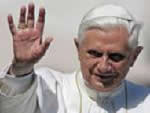|
Pope Benedict XVI- Angelus |
 Angelus
Message
Angelus
Message
On the Transfiguration
"To Pray Is Not to Evade Reality"
H.H. Benedict XVI
March 4, 2007
www.zenit.org
Dear Brothers and Sisters:
On this Second Sunday of Lent, the Evangelist Luke underlines that
Jesus went up the mountain "to pray" (9:28) together with the
apostles Peter, James and John and, "as he was praying" (9:29) the
luminous mystery of his transfiguration took place.
For the three apostles, to go up on the mountain meant to be
involved in Jesus' prayer, who often withdrew to pray, especially at
dawn or after sundown, and sometimes during the whole night.
However, on that occasion alone, on the mountain, he wished to
manifest to his friends the interior light that invaded him when he
prayed: His face -- we read in the Gospel -- his countenance was
altered and his raiment became dazzling, reflecting the splendor of
the divine person of the Incarnate Word (cf. Luke 9:29).
There is another detail in St. Luke's narrative which is worth
underlining: It indicates the object of Jesus' conversation with
Moses and Elijah, who appeared next to him when transfigured. The
Evangelist narrates that they "spoke of his departure (in Greek, 'exodos'),
which he was to accomplish at Jerusalem" (9:31).
Therefore, Jesus listens to the Law and the prophets that speak to
him of his death and resurrection. In his intimate dialogue with his
Father, he does not leave history, he does not flee from the mission
for which he came into the world, though he knows that to attain
glory he will have to go through the cross. What is more, Christ
enters this mission more profoundly, adhering with all his being to
the will of the Father, and he shows us that true prayer consists
precisely in uniting our will to the Father's.
Therefore, for a Christian to pray is not to evade reality and the
responsibilities it entails, but to assume them to the end, trusting
in the faithful and inexhaustible love of the Lord. For this reason,
the proof of the Transfiguration is, paradoxically, the agony in
Gethsemane (cf. Luke 22:39-46). Given the imminence of the passion,
Jesus experiences mortal anguish and entrusts himself to the divine
will; at that moment his prayer is a pledge of salvation for us all.
Christ, in fact, would implore the heavenly Father to "save him from
death" and, as the author of the Letter to the Hebrews writes, "he
was heard for his godly fear" (5:7). The Resurrection is proof that
he was heard.
Dear Brothers and Sisters: Prayer is not something accessory, it is
not "optional," but rather a question of life or death. Only one who
prays, that is, who entrusts himself to God with filial love, can
enter into eternal life, which is God himself. During this season of
Lent, let us pray to Mary, mother of the Incarnate Word and teacher
of the spiritual life, to teach us to pray as her Son did so that
our life is transformed by the light of his presence.
[Translation by ZENIT]
[After praying the Angelus, the Pope greeted pilgrims in several
languages. In English, he said:]
I offer a warm welcome to the English-speaking visitors gathered for
the "Angelus" prayer, including the group from Saint Brigid's parish
in Killester, Dublin. Today's Gospel invites us to ponder the
mystery of Christ's Transfiguration, to acknowledge him as the
Incarnate Son of God, and to follow him along the way that leads to
the saving mystery of his Cross and Resurrection. During this Lenten
season, may you grow closer to the Lord in prayer, and may he shed
the light of his countenance upon you and your families!
© Copyright 2007 -- Libreria Editrice Vaticana
Look at the One they
Pierced!
This page is the work of the Servants of the Pierced Hearts of Jesus and
Mary